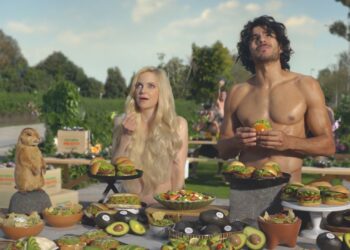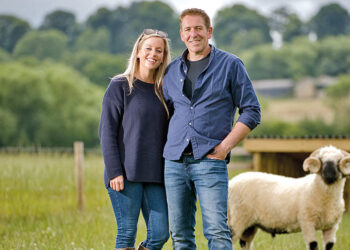Lille Allen/Eater
Whether you’re a vegetarian or want to diversify your protein sources, these cookbooks make strong arguments in favor of the magical legume
Like tinned fish, beans have gotten a glow-up in the past few years, going from a taken-for-granted pantry staple to an ingredient of borderline-fetishistic renown. There have been many arguments in favor of eating more beans — namely, their affordability relative to other protein sources, their environmental benefits, and their wholesome nutritional breakdown. Still, there’s room for persuasion: As the writer Bee Wilson recently asked in the New York Times, “[H]ow can millions of people divert some of their love for meat toward beans?”
Three new cookbooks make strong, but slightly different, arguments in favor of more — and better — bean consumption. None are particularly pedantic; instead, each one approaches beans primarily through the lens of deliciousness: Why wouldn’t you eat more beans, when beans can be so good?
The Bean Book: 100 Recipes for Cooking with All Kinds of Beans, from the Rancho Gordo Kitchen
Steve Sando with Julia Newberry
Ten Speed Press, September 10
Who better to trust with beans than Steve Sando, whose beloved company Rancho Gordo boasted a 2022 waitlist of 40,000 people interested in its Bean Club? If you want to know about eating better beans, Sando is your guy. Rancho Gordo heralds new-crop and heirloom beans, like rare black chickpeas and dappled vaqueros; these, like heirloom tomatoes, offer more flavor than their commodity counterparts, which have been bred to maximize yield. The Bean Book aims to demystify beans, especially for eaters whose experience with beans might start and end with their less flavorful canned form.
This is the book for cooks who want to know the most: One section details the differences between 50 different bean varieties, and you’ll also find a consideration of phytohaemagglutinin, a toxin that can be present in some beans. Complete with historical information about bean cultivation and cookery, The Bean Book is a comprehensive primer on not just how to cook beans but also why. “Your simple act links you to your ancestors and the land around you,” explains Sando, who wrote the book with Julia Newberry. Because not every batch of beans cooks the same, Sando argues, making a pot requires paying attention and being truly connected to your food.
The Bean Book positions beans as a staple for cooks of any diet, which is to say that its recipes sometimes call for fish, meat, and lard; white beans on toast get a (optional) topping of lardo, for example. Useful and wide-ranging, the book categorizes its 100 recipes by dish type (i.e. bean stews), and from there, the recipes take global inspiration: Italian tuna and white bean salad; Brazilian caldinho de feijão, or black bean soup; Mexican carne en su jugo. While The Bean Book does ultimately highlight ways to use Rancho Gordo’s specific beans, its recipes are also written with substitutes to keep more commercially available beans as an option. Beans, after all, are for everyone.
The Yearlong Pantry: Bright, Bold Vegetarian Recipes to Transform Everyday Staples
Erin Alderson
Hardie Grant, October 22
The creator of the blog Naturally Ella, Erin Alderson makes a vegetarian argument in favor of beans. Unlike vegetarian books that prioritize fresh vegetables and tether their utility to the seasons, Alderson focuses on year-round pantry staples, arranging her book around the categories of grains, legumes (which beans belong to), and nuts and seeds. These are recipes that position legumes (or grains or nuts) as central, and adjust their fresh elements depending on what’s in season. She suggests adding sweet corn to her greens and lima beans gratin in the summer; in the winter, you might swap in broccoli instead.
Alderson explains that when she first became vegetarian, she began to eat more beans but still viewed them through a “meat-centric” lens, tossing chickpeas in Frank’s RedHot, for example. But as she gained experience in the kitchen, she writes, she “shed [her] initial understanding of beans.” While her book features an In-N-Out-inspired black bean smash burger, she’s more interested in relying on the inherent deliciousness of well-cooked beans (on that point, she offers useful guidance) in recipes like charred chimichurri ayocote beans over whipped ricotta, or big beans in tomato-miso broth. The legumes chapter offers recipes for beans, chickpeas, lentils, and soybeans, the latter primarily in the form of tempeh.
The focus on grains, legumes, and nuts makes the recipes in The Yearlong Pantry satisfying on their own — there is no need to think about how to bulk a vegetable dish into a full meal because Alderson has already done the work by, for example, pairing romesco Mayocoba beans with polenta or serving her harissa baked bean toast with a salad dressed with creamy feta. While Alderson’s book is clear about its vegetarian orientation, its emphasis on making the most out of the pantry — serving barley like risotto, or turning chickpea flour into Shan tofu — will be useful for anyone who wants another source of protein or simply to cook more frugally, sustainably, and creatively.
Justine Cooks: A Cookbook: Recipes (Mostly Plants) for Finding Your Way in the Kitchen
Justine Doiron
Clarkson Potter, October 29
“Beans, a full sentence,” proclaims recipe developer and TikTok star Justine Doiron in one chapter of her debut cookbook, Justine Cooks. “I think it’s okay to say I have a mild bean obsession.” Doiron takes an of-the-moment approach to dietary restrictions: She’s pescatarian but tries to “keep that on the DL,” she writes, having learned that when she doesn’t call it out, people don’t usually notice. In another chapter, she classifies tofu and fish as “my kind of proteins.”
Indeed, for some recipe developers, Doiron presumably included, this approach can be a way to get cooks excited about vegetables — or beans — on their own merits, without bringing the baggage of dietary exclusion to the table. Doiron’s recipes make beans satisfying on their own and even casually exciting; consider the way she tosses canned butter beans in seasoned flour, roasts them until they’re golden brown and crispy, and serves them with nutty zhug. This is one of those little tricks that makes a good cookbook so useful: From there, the crispy beans can become a formula to be used with another bean or sauce. Or consider the book’s cover star: beans sizzled with olives and topped with crispy sage and ricotta salata. It’s another way that Doiron shows how beans can be simple yet satisfying all on their own, and serve as an anchor protein in a varied diet.
Throughout Justine Cooks, Doiron’s recipes are simple but no less delicious: The familiar, easy concept of beans and escarole gets new life with gochujang and black vinegar; lentils are zhuzhed up with “sticky shallots” and dukkah. The recipes that aren’t beans — admittedly, the majority of them — focus on produce and have a home-cook-friendly eye towards restraint and reusing pantry staples. It’s through her accessible yet unconventional recipes that Doiron sneakily makes an argument for a more varied and flexible diet, one in which meat doesn’t have to be a given when there are so many other proteins, beans among them, to be excited about.














